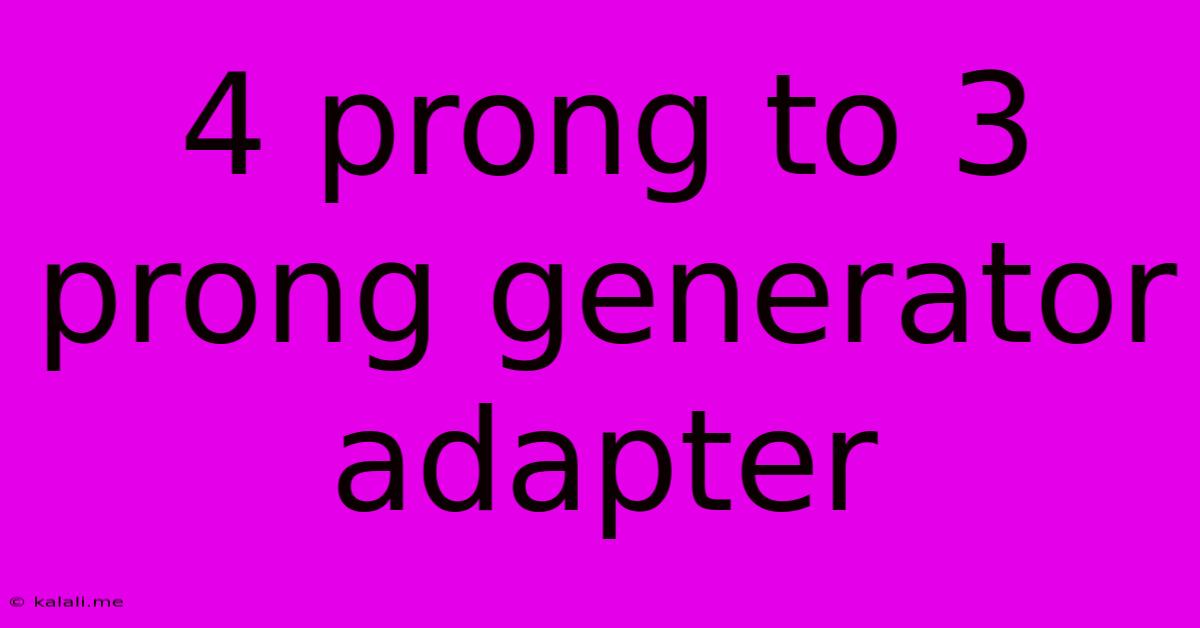4 Prong To 3 Prong Generator Adapter
Kalali
Jun 06, 2025 · 3 min read

Table of Contents
Converting 4-Prong to 3-Prong: A Safe Guide to Generator Adapters
Are you struggling to connect your generator to your home's electrical system because of a mismatch in plugs? Many older homes use a 3-prong system, while many generators come equipped with a 4-prong L14-30 receptacle. This article explains how a 4-prong to 3-prong generator adapter works and the crucial safety considerations you must keep in mind. Using the wrong adapter can be extremely dangerous, potentially leading to electrocution or fire.
What's the Difference Between 4-Prong and 3-Prong Outlets?
The key difference lies in the grounding. A 4-prong outlet (L14-30) provides a dedicated ground wire, significantly improving safety by providing a path for fault currents to safely flow to the earth. This setup is essential for high-power appliances to prevent electrical shocks and potential fires. A 3-prong outlet typically utilizes the metal casing of the appliance or a neutral wire as a ground, offering less robust safety.
The Risks of Using a 4-Prong to 3-Prong Adapter
Using a 4-prong to 3-prong adapter effectively removes the dedicated ground. This means that if a fault occurs in your generator or the connected appliance, there's a significantly increased risk of:
- Electric Shock: A faulty appliance can send a dangerous electrical current through the adapter and into the user if they touch it.
- Fire Hazards: Electrical faults can lead to overheating and potential fires, particularly without a proper ground path to dissipate the excess current.
- Equipment Damage: Lack of proper grounding can damage sensitive electronics.
When is a 4-Prong to 3-Prong Adapter Acceptable (With Extreme Caution)?
It's crucial to understand that using an adapter is generally NOT recommended. However, in some limited scenarios, it might seem unavoidable. Before considering this, consult a qualified electrician. Only use a properly rated and designed adapter, and ONLY if:
- Your generator's manual explicitly states compatibility with 3-prong systems. This is rare, and many manuals strongly discourage using adapters.
- You completely understand the inherent risks. You are willing to accept the significantly increased risk of electric shock and fire.
- You're only powering appliances with robust built-in grounding systems. This minimizes the risk, but doesn't eliminate it entirely.
Safe Alternatives to Adapters:
Instead of relying on adapters, consider these safer alternatives:
- Professional Electrical Installation: The safest and most recommended approach is to have a qualified electrician install a dedicated 4-prong outlet in your home's electrical panel.
- Using Appliances with 3-Prong Plugs: If possible, use only appliances with 3-prong plugs designed for your home's electrical system.
- Generator with 3-prong output: Consider purchasing a generator with a built-in 3-prong outlet for better compatibility.
Conclusion:
While 4-prong to 3-prong generator adapters exist, using them is inherently risky. The potential dangers of electric shock and fire significantly outweigh any convenience they may offer. Always prioritize safety and consider professional electrical work or alternative solutions before attempting to use such an adapter. Remember, your safety and the safety of your home should always come first.
Latest Posts
Latest Posts
-
Why Does Mold Like To Grow On Wheatgrass
Jun 07, 2025
-
Black Wire Is Negative Or Positive
Jun 07, 2025
-
Why Does Green Tea Sink To Bottom Of Cup
Jun 07, 2025
-
Toilet Bowl Water Level Drops Overnight
Jun 07, 2025
-
Edit Sharepoint List Add New Item Screen
Jun 07, 2025
Related Post
Thank you for visiting our website which covers about 4 Prong To 3 Prong Generator Adapter . We hope the information provided has been useful to you. Feel free to contact us if you have any questions or need further assistance. See you next time and don't miss to bookmark.